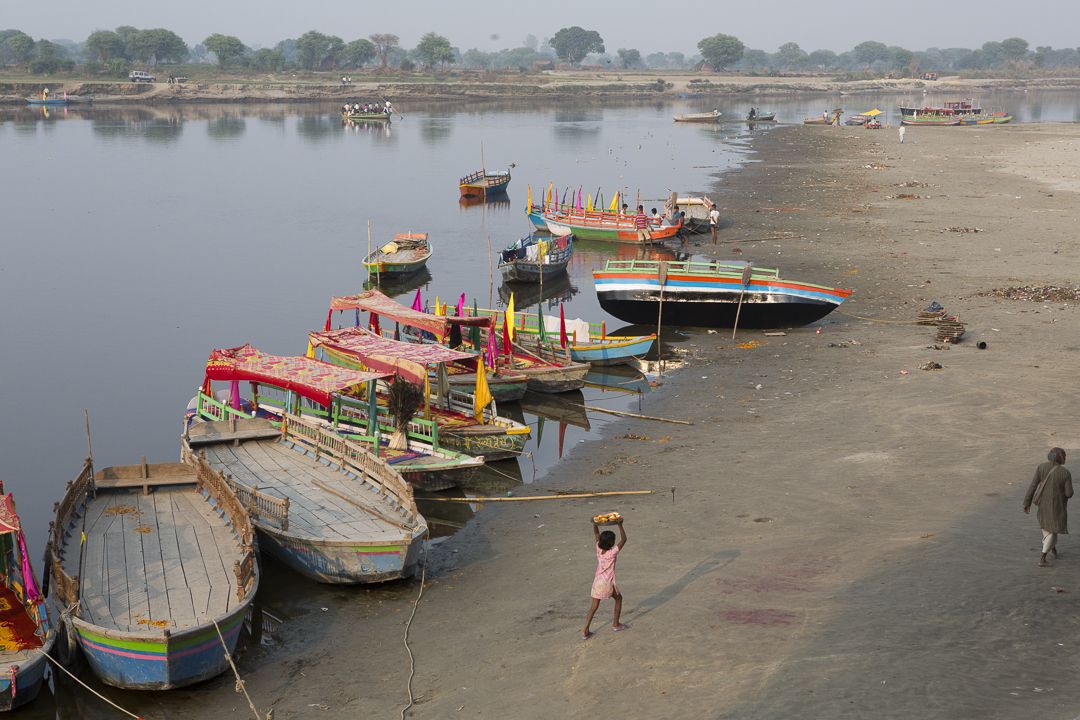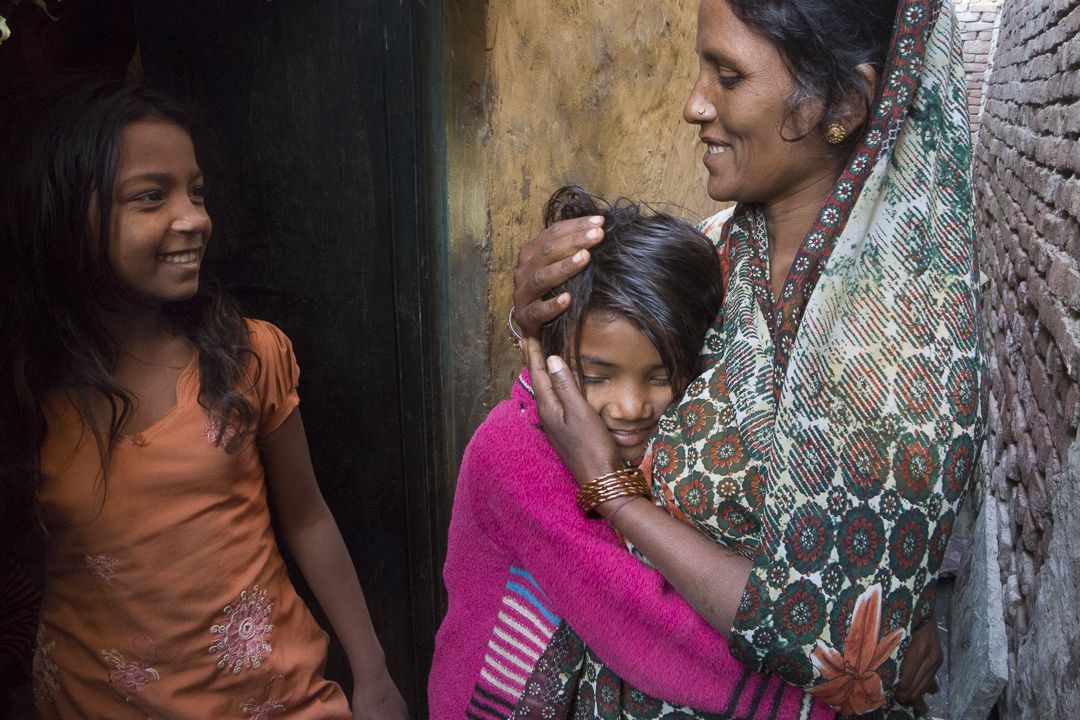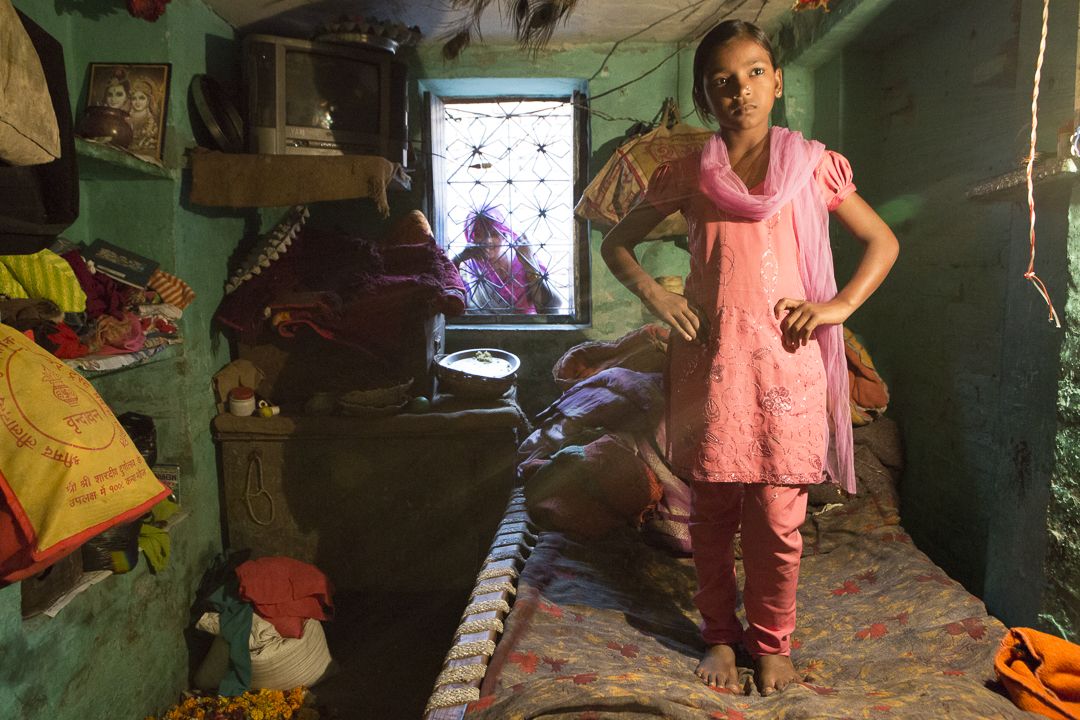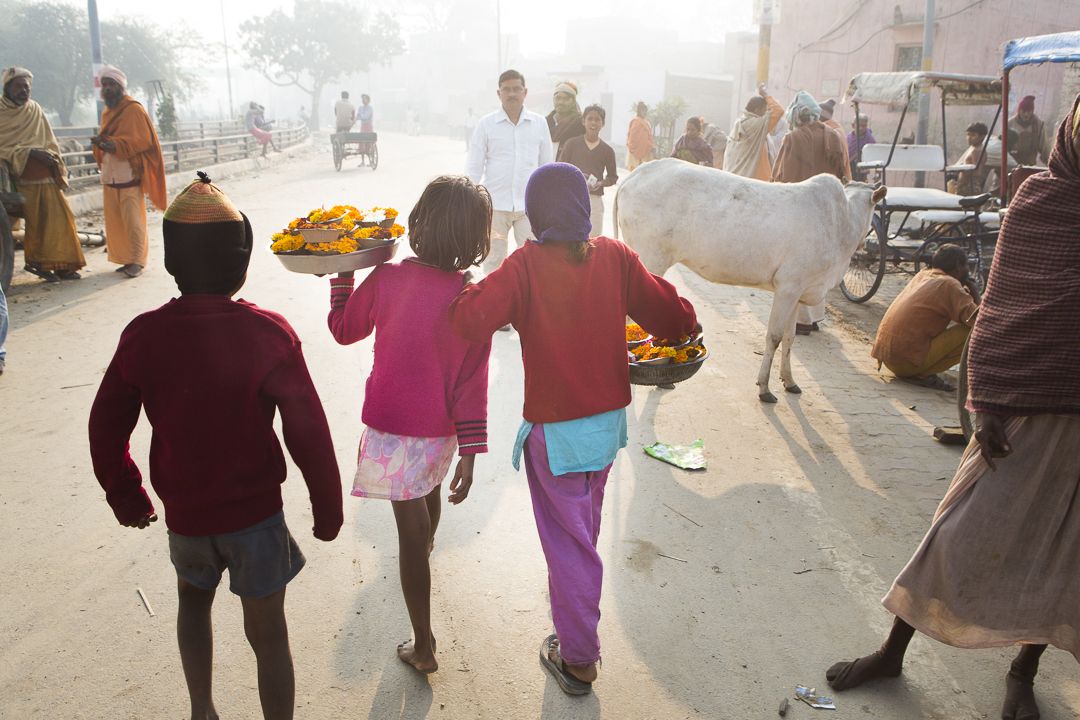With support from the Pulitzer Center on Crisis Reporting, photographer Amy Toensing and writer Jessica Benko spent several weeks living among the thousands of widows who populate the holy Braj region of rural Uttar Pradesh in northern India. There they investigated the taboos and social structures that leave many widows and their children struggling to survive.
The sandstone steps of the Keshi Ghat lead into the swift current of the Yamuna, the second most sacred river in Hinduism, an important stop for hundreds of thousands of pilgrims who visit the holy town of Vrindavan each year. At the foot of the ghat is a line of wooden barges strung with colorful flags, captained by teenage boys who use poles to guide the boats to sand bars in the river where those willing to pay can bathe away from the trash strewn banks.
Two young boys stand knee deep, tossing stacks of magnets tied with string into deeper water and dragging them across the river bottom, hoping to capture coins tossed in by the bathers. A small girl in a threadbare pink tunic patrols near the beached boats, steadying a tray of red, orange, and yellow marigolds balanced on her head. As a family climbs into one of the boats, she clambers onto the one next to it, leaning across the wooden rail to accept 5 rupees (about 8 cents) for a small cup of the flowers, which will be offered to the river in prayer.
The flower girl is 8 years old and her name is Gunjan, a Sanskrit word that describes the pleasant humming sound of a bumblebee. She spends her days—all the daylight hours, every day of the week—hovering at the river’s edge, collecting a few rupees at a time from as many bathers as she can. She’s a beautiful child, quiet, not aggressive but vigilant for new arrivals to the banks, and many of the visitors choose her flowers. She buys marigolds every few days—200 rupees for a bag as wide as her arms can reach, 100 rupees for sack as wide as her tiny shoulders—and arranges them in small bowls made of pressed leaves, each topped with a wick soaked in ghee that she can light expertly with a match, even on the windiest of days.
When school is out, a gaggle of other children come down to the river banks to play. They draw a sort of hopscotch court in the sand with a stick for a game they call titi, tossing a rock to a farther box with each turn, hopping in every square that hasn’t already been captured. When they’ve gotten through the whole board, they make it harder for themselves, tilting back their heads and fixing their gaze up at the sky as they jump.
Gunjan directs her friends in her small, hoarse voice, moving the game along briskly. Her attention to her work never wavers, though, and each time a new group shows up at the foot of the ghat, she sweeps her flowers back onto her head, and strides away to greet them. On a quiet day like this one when no one else bothers to compete with her, she might still bring home 100 or 150 rupees (about $1.60-$2.40) after the cost of flowers—more than many adult unskilled day laborers make—and on a busy, auspicious holiday, she can make quite a bit more. And that’s the source of one of the biggest dangers to Gunjan’s future.
She lives with her mother Meena, and three siblings—sisters Tanuja, 13, and Hema, 5, and brother Shiva, 3—in a 6ft x 10ft room tucked into a maze of buildings up the hill from the river. Her father died three years ago from a septic infection after being stabbed by his brother over a property dispute. Meena is illiterate and can only get occasional work as a day laborer, so 8-year-old Gunjan has assumed responsibility for supporting the family of five. She hasn’t been to school in a year or maybe two.
The flower-selling work falls to Gunjan because although her older sister Tanuja looks much younger than 13, she is on the cusp of puberty and in their conservative neighborhood, where women must veil their faces in the presence of male relatives, it is considered dangerous for her to be out of the house. If her mother is able to get a day of work, Tanuja strings prayer beads at home while watching after Hema and Shiva. When her mother doesn’t find work, Tanuja has the chance to go to school, the only acceptable destination for her outside the home. She loves school, but she knows she will be married before long and she worries what her mother will do without her help once she is taken away from home to her new husband’s village.
“If you give me money, I can get her married,” Meena pleads with us another day, apparently unaware that our instinct would be to give her money to delay Tanuja’s marriage, rather than encourage it. But her rationale, in these circumstances, is understandable. If a girl is past puberty and unmarried, it is considered a mark of a family’s bad morals, which can be perversely interpreted as justification for sexual assault. From Meena’s perspective, the only way to protect Tanuja is to get her married as soon as possible, though without any money from her family, the only suitors will be men so undesirable that they have no chance of attracting a bride with a dowry.
Gunjan’s future looks no brighter. Unlike Tanuja, she wasn’t in school long enough to learn to read and write before their father died, and now there is little chance for Gunjan to get back into school, not while her income is so vital for the family. She’ll continue selling flowers until she, too, is approaching puberty. When that happens, it will be Hema’s turn as flower girl.
There’s no indication that the cycle is about to break. Meena, too, was married as a young teenager, kept strictly in the house by her husband, dependent on him, and then rejected by his family after he was killed. Her own family, in a village hours away, has six brothers without enough resources to split among themselves, much less with her. Her girls are headed down the same path, and because of their poverty, they are likely to be married to much older men, who may leave them as unskilled, illiterate widows with young children, as their mother is now.
But tomorrow, dawn will break over the river and over little Gunjan, standing at the water’s edge with a tattered pink sweater against the winter chill, one arm wrapped around her waist, elbow propped on her hip, another day’s bright flowers resting in the palm of her hand.
There are 35 million widows in India, where the marriage of girls to much older men makes widowhood a common outcome, and many are shunned as bad luck and can lose their status and ability to support themselves. Find out more about Benko and Toensing’s project here.













